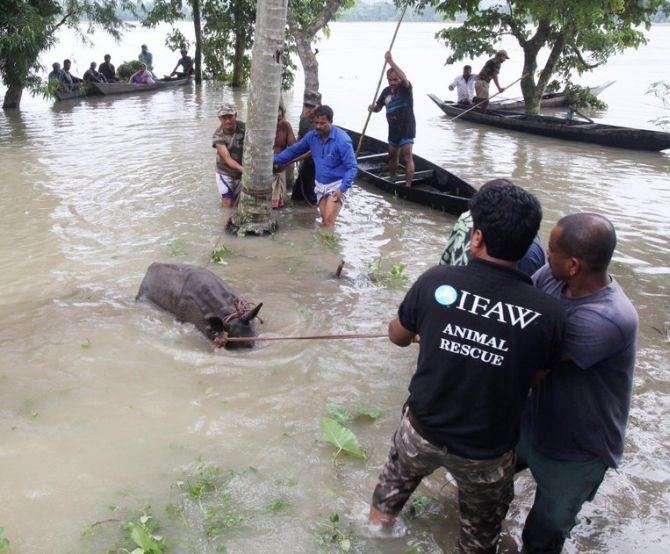'Flooding forces the animals to disperse out of the park that, in turn, attracts the attention of poachers.'

As the monsoon lashes across India, Assam is tackling a flood situation that has displaced lakhs of residents in the state.
Other than its human occupants, wildlife, including the one-horned rhinoceros, is also facing a dire situation.
Besides the challenge of saving rhinos and elephant calves from the treacherous water is the fear that a rescue operation may scare them into jumping right into the water. Ashraf Nvk, senior director and chief veterinarian at the Wildlife Trust of India, speaks to Manavi Kapur about how the impact of these and future floods can be reduced on the wildlife in Assam.
What is currently the condition of the rhinos affected by the floods? Where do you think will they be rehabilitated?
Eight rhino calves were admitted in a span of four days to the Centre for Wildlife Rehabilitation and Conservation, Kaziranga. Four are males, the rest females. Their age varies from about three months to one year.
It was a pathetic sight to see them lying in our large animal nursery, resting most of the time. Except for one calf that had sustained some injuries, the rest looked alright externally.
All rhino and elephant calves take some time to get used to bottle feeding, especially given the trauma they have been through. The calves were reluctantly learning to suckle from bottles, and once fed properly, should be able to recover soon. They are all likely to be rehabilitated in the Manas National Park.

What has been the biggest challenge in carrying out rescue operations in Kaziranga? Has there been enough support from the authorities in prioritising wildlife?
In such situations, accessing the affected areas is the real challenge. When 80 per cent of the park gets flooded, the only option is to travel by boats.
However, if one actively travels on boats looking for stranded animals, animals that have taken refuge on small islands and mounds would get disturbed and jump into water. This can, in turn, be counter-productive and hence needs very tricky balance.
The strategy is not to approach them too closely.
In all this, the forest department has been very supportive and involved. In fact, we support their work in the mission to rescue stranded animals.
The flood fury in Assam has taken its toll on one of the world's most protected heritage sites -- The Kaziranga National Park.
As many as 218 animals, 17 of them being rhinos and over 166 hog deer, have drowned in a span of just seven days owing to the floods.
There have been frequent floods in Assam in the last few years. How can the authorities ensure that the animals are kept safe and are safeguarded against future incidents?
Flooding is normal for a park like Kaziranga because central Assam is a flood plain. It is only when the water level increases dramatically over a period of 24 hours that the impact is greater on wildlife.
Animals do not get enough time to search for higher areas and move out. This is what happened this year. We cannot prevent flooding from happening, but we can facilitate dispersal of animals from low lying areas to higher reaches (such as the Karbi Anglong Hills).
Unfortunately, there a lot of human settlements along the highway that roughly separates the part from the hill slopes of Karbi Anglong. Most of these are large resorts, and such human infrastructure blocks the safe movement of animals across the park to higher ground.
There are only three or four 'corridors' left for animals to use. The answer to minimise the impact of floods lies in wise, ecologically viable land use practices.
Wildlife needs to become a priority for not just the authorities but also for local residents and business owners. This is the only way forward.
Does this make the already endangered species vulnerable to poaching? How can this be prevented?
Yes, flooding forces the animals to disperse out of the park that, in turn, attracts the attention of poachers.
This is a very sensitive time that leaves animals more exposed. But ironically, it is also during the floods that there is increased patrolling on all sides.
The floods are also the time when the entire focus of the government machinery is on rescue operations and one hopes that illegal trade and poaching will be harder to accomplish.









